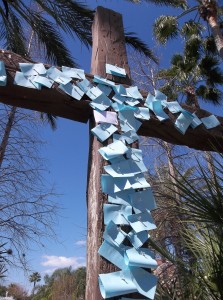 In Orlando, Florida people pin prayers to a cross. The cross stands on the grounds of the Holy Land Experience (HLE), a fifteen-acre “living, biblical museum” that teaches Christian themes in a themed environment eleven miles northeast of the Walt Disney World Resort. HLE is a site on the American religious landscape where materiality flourishes: religious history and textual ideologies are re-presented in a way that fuses evangelical commitments with the logics of immersive entertainment.
In Orlando, Florida people pin prayers to a cross. The cross stands on the grounds of the Holy Land Experience (HLE), a fifteen-acre “living, biblical museum” that teaches Christian themes in a themed environment eleven miles northeast of the Walt Disney World Resort. HLE is a site on the American religious landscape where materiality flourishes: religious history and textual ideologies are re-presented in a way that fuses evangelical commitments with the logics of immersive entertainment.
HLE’s “Testimony Cross Garden” exemplifies this site’s ongoing effort to document the many diverse ways in which pray-ers pray and prayers are prayed. We can observe much in the way of constitutive material acts. We might begin with the writing itself. Like keeping a daily prayer journal or submitting a prayer card to Oral Roberts, a power is harnessed by putting pen to paper, externalizing human interiors. (This extends the associations between writing technologies and faith emphasized by other Christian performances, as when one sings the opening lines of the Gospel standard When God Dips His Love in My Heart: “When God dips His pen of love in my heart and writes my soul a message He wants me to know…”) Then there is the folding. Each prayer is bent; some loose and uneven, some tight and perfectly aligned. Folding eases a tension between the public quality of the cross and the secrecy of each paper’s contents (“this is just between me and God”). Once folded, there is the pinning, attaching, affixing; full of iconicity. The park map that each guest receives when entering prompts us to “nail your burdens (prayer requests) to the cross.” And, there are numerous bodily tactics at work: taking the paper, holding the pen, reaching up, kneeling down, stretching left or right, touching the cross.



